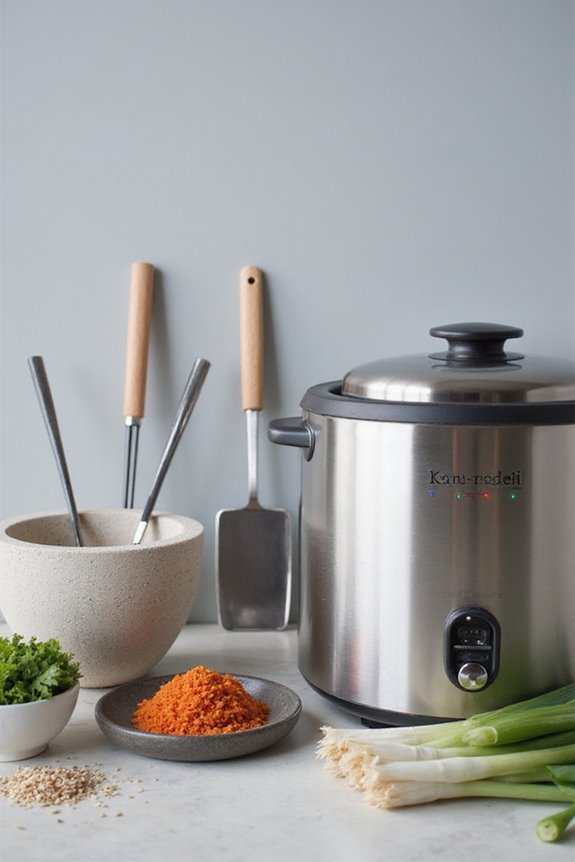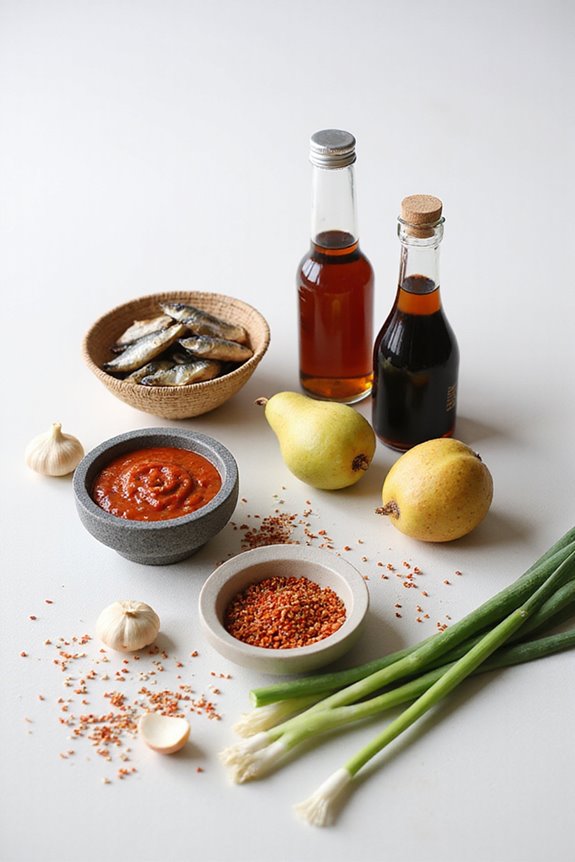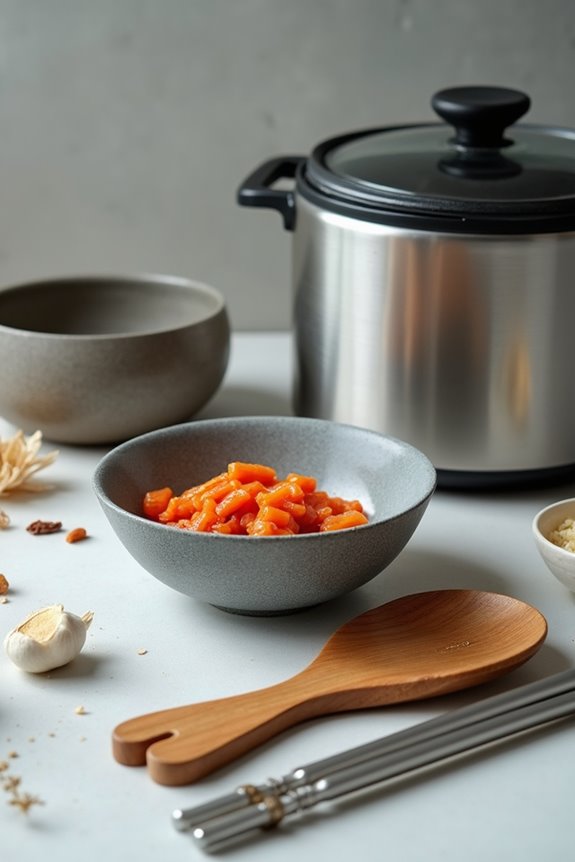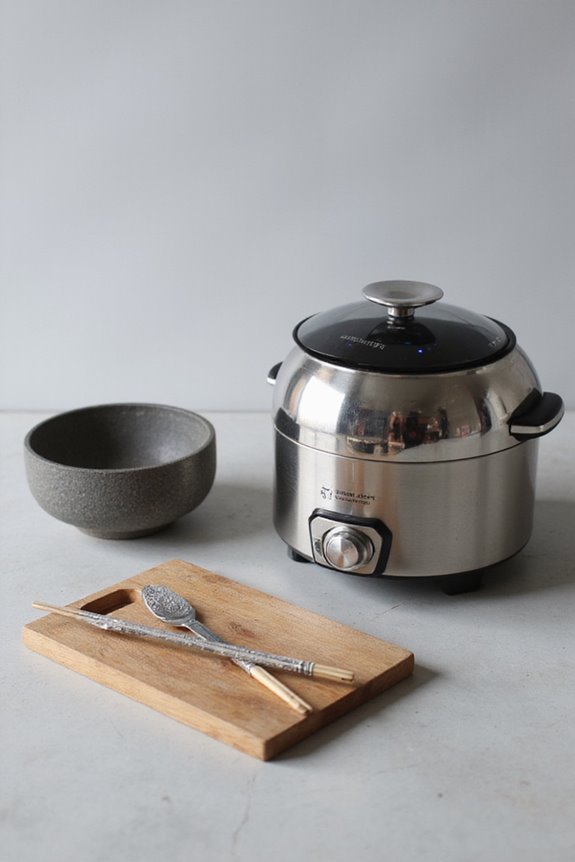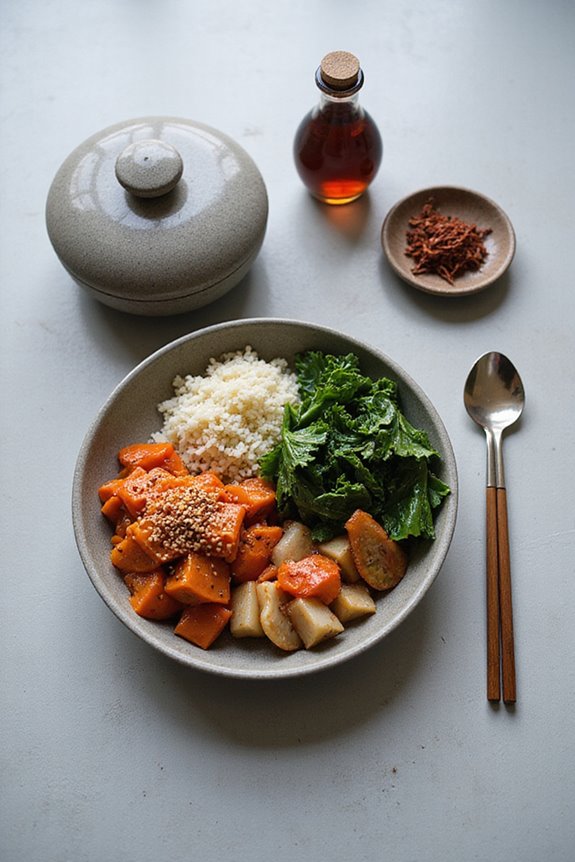To learn Korean cooking, we need to start by stocking our pantry with essential ingredients like gochujang, doenjang, and ganjang. These fermented pastes form the foundation of Korean flavors, while other staples like rice and gochugaru enhance our dishes. Mastering techniques such as marination, slow simmering, and grilling will elevate our cooking. Exploring key dishes like kimchi and bulgogi will help us understand regional diversity. By engaging with Korean culinary culture, we’ll deepen our appreciation for this vibrant cuisine.
Key Takeaways
- Start by stocking a Korean pantry with essential ingredients like gochujang, doenjang, and ganjang for authentic flavors.
- Learn and practice key cooking techniques such as marination, flavor layering, and slow simmering to enhance your dishes.
- Explore popular Korean dishes, like kimchi, bulgogi, and bibimbap, to familiarize yourself with traditional flavors and cooking methods.
- Engage in communal cooking experiences with friends or family to appreciate the cultural significance and enjoy shared meals.
- Take online classes or follow cooking tutorials to develop hands-on skills and gain confidence in Korean cuisine.
Understand Essential Ingredients
When we begin our journey into Korean cooking, understanding the essential ingredients is fundamental to achieving authentic flavors and textures in our dishes. Key components include fermented pastes, such as gochujang, doenjang, and ganjang. Gochujang, a chili pepper paste, offers a unique blend of spiciness and sweetness, while doenjang provides a strong, savory depth important for soups and stews. Ganjang, or fermented soy sauce, is essential for seasoning and marinating. Additionally, we can’t overlook important spices like gochugaru, a Korean chili powder that adds balanced heat and color to many dishes. Combining these ingredients allows us to explore the rich flavors of Korea, making each meal an authentic experience. Understanding these basics is a strong foundation for cooking. Furthermore, utilizing high-quality, all-natural ingredients enhances the overall flavor and authenticity of your dishes.
Building a Korean Pantry
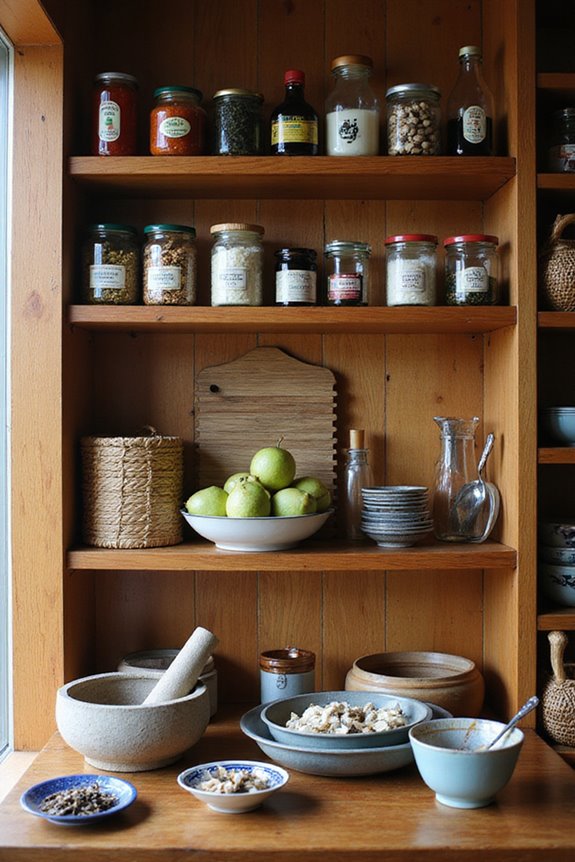
To effectively immerse ourselves in Korean cooking, building a well-stocked pantry is essential, as it provides the necessary ingredients for creating authentic dishes. Korean pantry essentials include the foundational fermented pastes known as jang, such as ganjang, doenjang, and gochujang. These pastes, produced through traditional fermentation techniques, enhance the flavor profiles of various soups, stews, and marinades. We also need staple ingredients like short-grain white rice, rice flours, and various starches, each playing a crucial role in achieving the desired textures in Korean recipes. Including aromatics like garlic and ginger, along with quality oils and vinegars, allows us to layer flavors. In addition, incorporating seafood-based items like dried anchovies and seaweed is fundamental for authentic seasoning in our Korean cooking. Utilizing authenticity in ingredients ensures that the dishes we create truly reflect the depth of Korean culinary traditions.
Mastering Korean Cooking Techniques
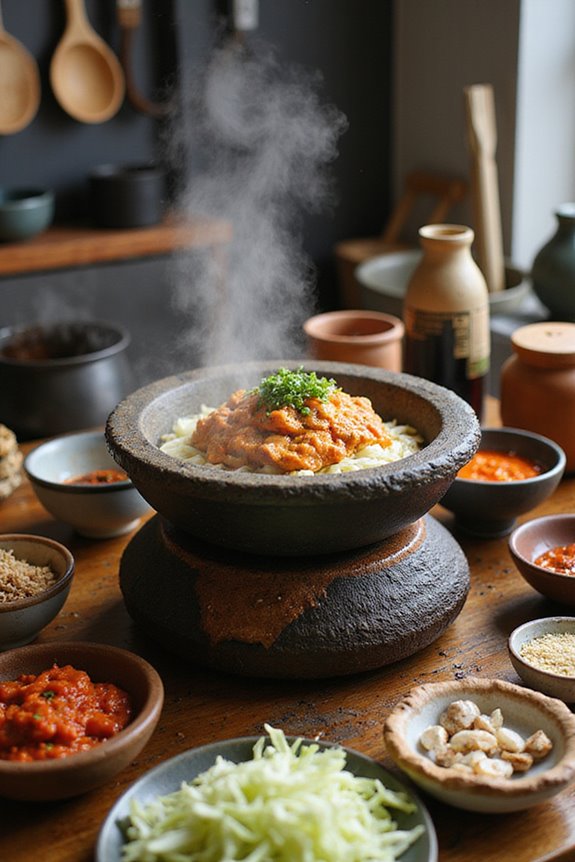
Mastering Korean cooking techniques is essential for creating authentic dishes that reflect the rich culinary history and culture of Korea. Effective marination techniques are vital, as they infuse proteins and vegetables with deep, complex flavors, often using ingredients like soy sauce, garlic, and sesame oil. For example, bulgogi’s thinly sliced beef absorbs the marinade, resulting in a tender, savory dish. In addition, flavor layering enhances depth by combining fermented pastes, fresh aromatics, and umami-rich ingredients. Techniques such as grilling over an open flame and slow simmering for soups foster a balance of textures and tastes. By understanding these methods and their historical significance, we can create dishes that not only satisfy the palate but also honor Korea’s culinary traditions.
Exploring Key Korean Dishes
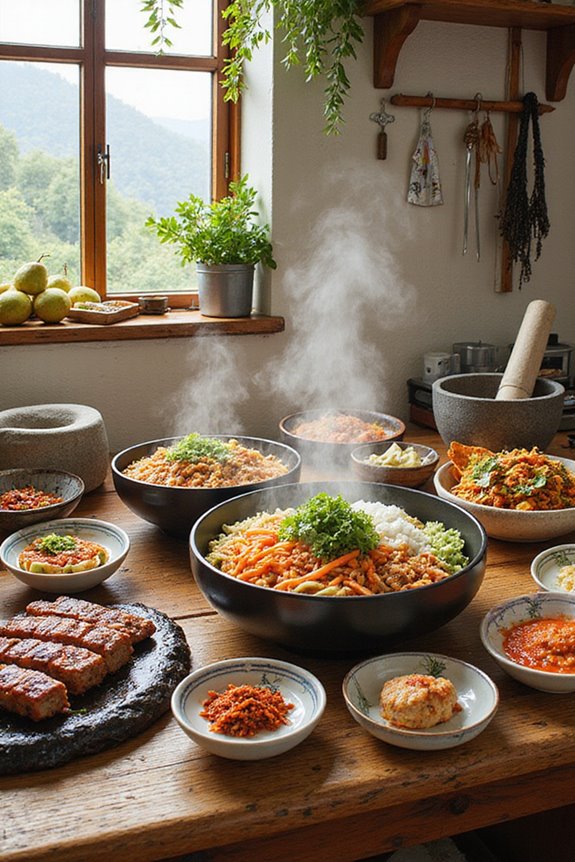
Exploring key Korean dishes introduces us to a diverse array of flavors and culinary techniques that define the country’s cuisine. At the heart of Korean gastronomy lies kimchi, with its many variations offering a flavorful experience; from traditional kimchi jjigae to modern kimchi fries, this fermented staple is essential to our meals. Korean fried chicken, distinguished by its double-frying technique, has gained international acclaim, notable for its crisp texture and juiciness. Whether seasoned with soy garlic or spicy gochujang, the flavors are a delight. Additionally, when paired with dishes like bibimbap or bulgogi, these elements create a harmonious dining experience that showcases the complexity and depth of Korean cooking and reflects how cuisine can evolve through cultural exchange. Using high-quality Korean food seasoning sets can significantly enhance the flavors of these traditional dishes.
Stocking Up on Additional Staples
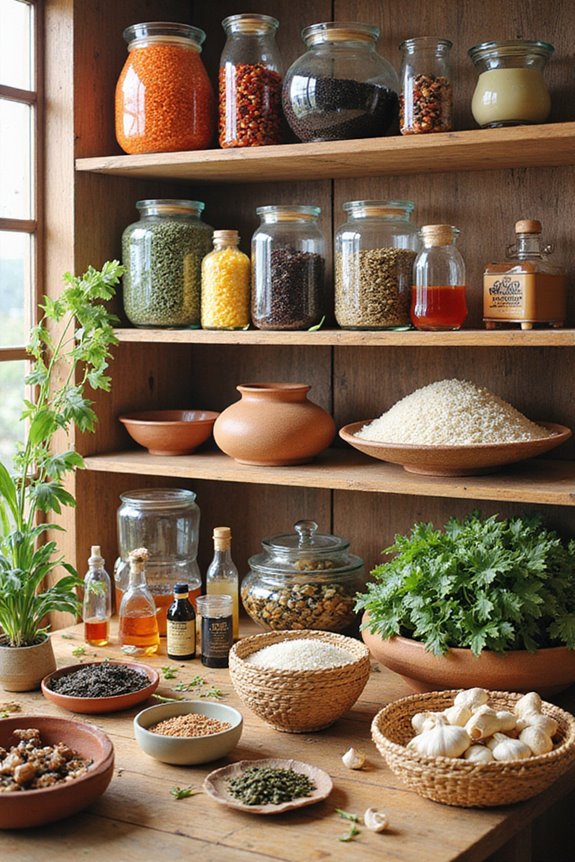
When we think about stocking up on additional staples for Korean cooking, it’s important to contemplate a variety of essential ingredients that enhance the depth of flavors in our dishes. We should prioritize staples like gochujang and doenjang, which provide a savory foundation for a multitude of recipes. Additionally, stocking essentials such as dried anchovy and dashima will be crucial for crafting rich stocks, while gochugaru brings a unique smokiness to our meals. Aromatics like garlic and ginger are indispensable for creating authentic flavor profiles, complementing salads or stews. Finally, including rice, noodles, and various proteins ensures we can explore flavors across different Korean dishes, making our kitchen a versatile space for culinary experimentation. Incorporating tools like stainless Korean cooking scissors can greatly enhance efficiency during meal prep, allowing for effortless cutting of ingredients.
Finding and Selecting Ingredients
Finding and selecting quality ingredients is essential for authentic Korean cooking, as the right components greatly influence the final dish’s flavor and authenticity. We should prioritize local sourcing whenever possible, as this often guarantees ingredient freshness and supports our community. Asian markets and Korean grocery stores are excellent places to find staples like gochujang, gochugaru, and doenjang. When selecting these items, we must check for brand reputation, such as Sunchang or Haechandle, and examine their fermentation processes, which affect flavor quality. Additionally, checking expiry dates guarantees the ingredients are fresh. For produce, farmers’ markets may provide fresher green onions and garlic. By being mindful of where we source our ingredients, we can enhance our Korean cooking experience considerably.
Practicing Authentic Recipes
Practicing authentic recipes is essential for anyone looking to master Korean cooking, as it helps develop important skills and a deep understanding of flavors. By following step-by-step instructions for traditional dishes like bulgogi and doenjang jjigae, we can grasp the significance of using authentic ingredients such as gochujang and sesame oil. Employing traditional cooking techniques, including stir-frying and slow-cooking, is critical for achieving the proper textures and flavors. Additionally, experimenting with recipe variations, like adjusting spice levels in kimchi fried rice, enables us to appreciate regional differences and personal creativity. As we repeat recipes, we not only refine our techniques but also build confidence, enhancing our overall culinary journey in Korean cuisine. Choosing the right kitchen strainer can significantly improve the quality of our dishes, especially when filtering stocks and sauces.
Engaging With Korean Culinary Culture
How do we truly engage with Korean culinary culture beyond just the recipes? One effective way is to participate in food festivals, where we can immerse ourselves in the vibrant range of Korean flavors and cooking techniques. These events often showcase traditional dishes, street food, and regional specialties, allowing us to connect with local culinary practices. Additionally, enrolling in culinary workshops offers hands-on experience in preparing classic dishes and ingredients, such as kimchi and banchan. Here, we can learn about historical influences, ingredient sourcing, and the importance of fermentation. Moreover, using tools like food mills can enhance our cooking experience by allowing us to create varied textures in sauces and purees. By engaging with these activities, we deepen our understanding of Korean cooking, its cultural significance, and the communal aspects that permeate this rich culinary landscape.
Frequently Asked Questions
What Kitchen Tools Are Essential for Korean Cooking?
When exploring the essential kitchen tools for Korean cooking, we’ll need sharp knives for our cutting techniques, a reliable rice cooker for essential ingredients like rice, and an earthenware pot for perfect stews.
How Do I Adjust Spice Levels in Korean Dishes?
Think of adjusting spice levels as fine-tuning a song. We can use spice substitutes, control gochujang and gochugaru, and find a flavor balance, ensuring our dishes sing with just the right amount of heat.
Can I Make Korean Food Vegetarian or Vegan?
Yes, we can absolutely make Korean food vegetarian or vegan! By using Korean ingredients and incorporating vegetarian substitutes, we can enjoy flavorful dishes like kimchi and bibimbap without compromising our dietary choices. Let’s get cooking!
How Long Do Homemade Kimchi and Sauces Last?
Funny how we often wonder about kimchi storage and sauce preservation together! Homemade kimchi can last up to 12 months, while sauces may be good for 3 to 6 months if stored properly in airtight containers.
Are There Any Korean Cooking Classes or Online Resources Available?
Yes, there’re plenty of Korean cooking classes available, both in-person and online! We can explore various online cooking resources that offer interactive experiences, helping us master delicious traditional dishes at our own pace.

